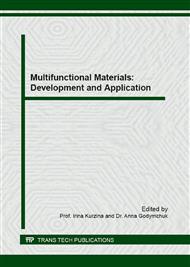[1]
W. Kwan, M. Ramli, K. Kam, M. Sulieman, Influence of the amount of recycled coarse aggregate in concrete design and durability properties, J. Constr. Build. Mater. 26, 1 (2012) 565-573.
DOI: 10.1016/j.conbuildmat.2011.06.059
Google Scholar
[2]
Y. Hongping, S. Liyin, Trend of research on construction and demolition waste, J. Waste Manage. 31 (2011) 670-679.
Google Scholar
[3]
R. Walker, S. Pavia, Moisture transfer and thermal properties of hemp-lime concretes, J. Constr. Build. Mater. 64 (2014) 270 – 276.
DOI: 10.1016/j.conbuildmat.2014.04.081
Google Scholar
[4]
C.S. Poon, Ann T.W. Yu, L.H. Ng, On-site sorting of construction and demolition waste in Hong Kong, J. Resour. Conserv. Recy. 32, 2 (2001)157–172.
DOI: 10.1016/s0921-3449(01)00052-0
Google Scholar
[5]
C.S. Poon, S.C. Kou, L. Lam, Use of recycled aggregates in molded concrete bricks and blocks, J. Constr. Build. Mater. 16, 5 (2002) 281–289.
DOI: 10.1016/s0950-0618(02)00019-3
Google Scholar
[6]
Yu.M. Bazhenov, Concrete Technology, Vysshaya shkola, Moscow [in Russian], (1978).
Google Scholar
[7]
A.V. Volzhenskiy, Concrete and products from the ash and slag materials, Stroyisdat, Moscow [in Russian], (1969).
Google Scholar
[8]
A.M. Wagih, H.Z. El-Karmoty, M. Ebid, S.H. Okba, Recycled construction and demolition concrete waste as aggregate for structural concrete, J. HBRC. 9 (2013) 193–200.
DOI: 10.1016/j.hbrcj.2013.08.007
Google Scholar
[9]
S.A. Abo-El-Enein, H.A. El-Sayed, A.H. Ali, Y.T. Mohammed, H.M. Khater, A.S. Ouda, Physico-mechanical properties of high performance concrete using different aggregates in presence of silica fume, J. HBRC. 10 (2014) 43–48.
DOI: 10.1016/j.hbrcj.2013.06.002
Google Scholar
[10]
E.M. Gartner, J.F. Young, D.A. Damidot, I. Jawed, Hydration of Portland cement, in: J. Bensted, P. Barnes (Eds. ), Structure and Performance of Cements, Spon Press, New York, 2002, p.57–113.
Google Scholar
[11]
K. Kovler, Enhancing water resistance of cement and gypsum-cement materials, J. Mater. Civil. Eng. 13, 5 (2001) 349-355.
DOI: 10.1061/(asce)0899-1561(2001)13:5(349)
Google Scholar
[12]
J.W. Bullard, H.M. Jennings, R.A. Livingston, A. Nonat, G.W. Scherer, J.S. Schweitzer, K.L. Scrivener, J.J. Thomas, Mechanisms of cement hydration, J. Cement Concrete Res. 41, 12 (2011) 1208-1223.
DOI: 10.1016/j.cemconres.2010.09.011
Google Scholar
[13]
Sh. T. Babaev, N.F. Bashlyko, V.N. Serdyuk, The Main Principals of Obtaining of High- Efficiency Cements with Low Water Demand, Stroyizdat, Moscow [in Russian], (1991).
Google Scholar
[14]
Sh. T. Babaev, N.F. Bashlykov, Y.V. Sorokin, Peculiarities of Technology and Properties of Concretes based on Cements with Low Water Demand, Stroyizdat, Moscow [in Russian], (1992).
Google Scholar


